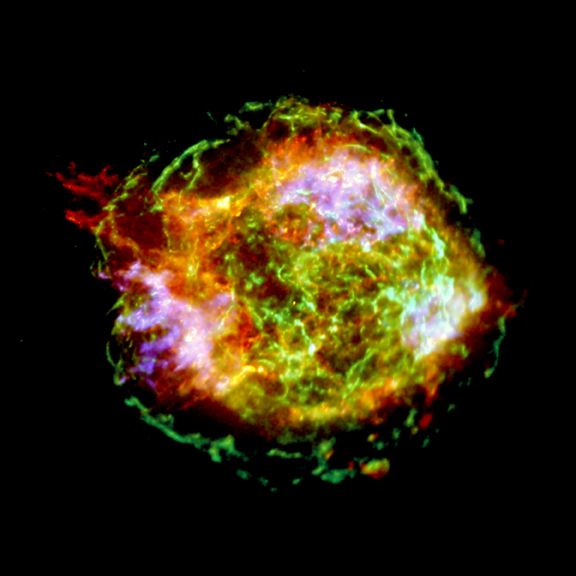Exploded Star Detailed in New X-ray Image

The Chandra X-ray Observatory has re-imaged a familiar scene of a relatively nearby exploded star, revealing new details of the chaotic aftermath.
The supernova remnant, as it is called, is named Cassiopeia A. It is about 10,000 light-years away.
Billowing clouds of superhot gas emanate from the site of the eruption, a star that has since collapsed into a neutron star. It is packed with nothing but neutrons huddled together so tightly that a teaspoonful, if brought to Earth, would weigh more than an elephant.
Chandra first imaged the exploded remains five years ago as its initial target after being launched into orbit. That exposure lasted about 90 minutes. The new photo involved more than 11 days of exposure time.
"Although this young supernova remnant has been intensely studied for years, this deep observation is the most detailed ever made of the remains of an exploded star," said Martin Laming of the Naval Research Laboratory. "It is a gold mine of data that astronomers will be panning through for years to come."
The rich detail has already paid off. Astronomers spotted previously unseen jets of material shooting in opposite directions ahead of the main, expanding cloud of material. The jets reach about 10 light-years from the neutron star.
"The presence of the bipolar jets suggests that jets could be more common in relatively normal supernova explosions than supposed by astronomers," said Una Hwang of NASA's Goddard Space Flight Center.
Breaking space news, the latest updates on rocket launches, skywatching events and more!
The new observations also showed that parts of the expanding bubble are rich in iron. Yet the far-reaching jets are rich in silicon and don't contain much iron. The researchers suspect the explosion generated a strong magnetic field that accelerated the high-speed jets. Theorists are not sure how these jets, which can approach the speed of light, are shot from neutron stars and black holes.
A paper on the observations by Hwang, Laming and colleagues will be published in Astrophysical Journal Letters.
- 5 Years Ago: The First Photo of Cas A
- Some of Chandra's Best Pictures

Rob has been producing internet content since the mid-1990s. He was a writer, editor and Director of Site Operations at Space.com starting in 1999. He served as Managing Editor of LiveScience since its launch in 2004. He then oversaw news operations for the Space.com's then-parent company TechMediaNetwork's growing suite of technology, science and business news sites. Prior to joining the company, Rob was an editor at The Star-Ledger in New Jersey. He has a journalism degree from Humboldt State University in California, is an author and also writes for Medium.
